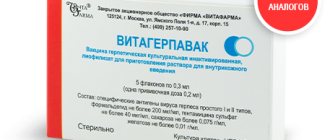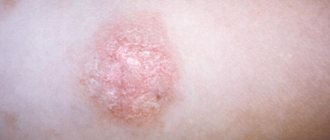Every mother dreams of giving birth and raising a healthy baby. Unfortunately, there are many dangers along the way of pregnancy, and one of them is the herpes virus, which is familiar to many. The virus can manifest itself in different ways: from itchy sores on the lips, poisoning a comfortable life, to the development of serious health-threatening conditions. In pregnant women, relapses can occur especially often, which is due to a natural decrease in immunity during pregnancy. During this difficult period, the expectant mother's immunity levels decrease. This condition is called physiological immunosuppression, which, on the one hand, helps to bear a child without rejecting him, and on the other, makes the body susceptible to various infections. Despite the fact that herpes on the lips is not considered a serious disease by most, herpes viruses can have an adverse and even fatal effect on the course of pregnancy and childbirth, leading in some cases to damage to the fetus.
- Herpes on the lips during pregnancy
- Why is herpes dangerous during pregnancy?
- An important aspect of protecting the body from viruses and germs
- Herpes during pregnancy. Is it possible to resist him?
- How to behave if the disease manifests itself
- How does the virus enter the body and why is it activated?
- Herpes zoster during pregnancy
- Who needs a herpes diagnosis?
- Herpes treatment regimen
- Effects of therapy with VIFERON
Herpes on the lips during pregnancy
The herpes simplex virus (Herpes simplex virus) of the first and second types is constantly present in the body in most people after infection in early childhood and under unfavorable conditions can be activated. It is known that by the age of fifteen, 80% of children and adolescents are infected with one or another herpes virus, and by the age of 30, 90% of people have antibodies to different types of this virus. The most common sites for infection are the genital area and surrounding skin, such as the buttocks, perineum, and face. Single or grouped itchy blisters appear on/on the nose, lips, cheeks, mouth, and on the mucous membrane of the eyelids. Recurrences of herpes during pregnancy are a very common occurrence, since a woman’s immune system during this period may not be able to cope with the virus that has once settled in the body.
Conclusion:
inflammatory changes in the reproductive organs of women with infertility are mainly a consequence of CHI (chronic herpesvirus infections). Herpes viruses and the factors they produce cause inflammation of the mucous membranes, destruction of the epithelium of the reproductive organs and suppression of the humoral immune system - all this leads to impaired fertility and infertility. In the Russian Federation we are talking about millions of patients.
Currently, according to epidemiological studies, up to 90% of the population is infected with the herpes simplex virus (HSV). Fortunately, despite this, the overall increase in fertility on the planet is still positive.
Why is herpes dangerous during pregnancy?
The greatest danger is posed by primary infection with herpes during pregnancy. Due to the absence of antibodies protecting against herpes in the mother’s body, the situation is characterized by more pronounced manifestations. For the fetus, the risk is especially high when infected with genital herpes in the first and third trimesters. Infection of the fetus in the first trimester leads to severe consequences, but such cases are extremely rare, since with the primary infection of a pregnant woman up to 10 weeks, as a rule, spontaneous termination of pregnancy occurs. The situation is considered extremely unfavorable in the case of primary infection in the second and third trimesters. However, primary infection in the second half of pregnancy almost always has a clear manifestation, which allows immediate action to be taken. HSV, while in the body, certainly reduces the “reserve” of health originally provided by nature. However, in the process of interaction with the virus, antibodies are formed that are passively transmitted to the newborn from the mother. With recurrent herpes or carriage of the virus, the risk to the fetus is assessed as minimal, since maternal antibodies help cope with the infection even in the event of an active relapse. With this form of infection, the virus is released less than with the primary one.
Causes
The herpes virus is transmitted from an infected person. Infection can occur either from a patient with severe symptoms or in a latent (asymptomatic) stage. The virus can be contained in all biological secretions of the patient (saliva, semen, contents of rashes, etc.).
Infection can occur in the following ways:
- airborne (through a kiss);
- contact and household (dishes, medical instruments, toys, etc.);
- sexual;
- transplacental (from mother to fetus during pregnancy);
- vertical (during childbirth);
- parenteral (through blood, for example, during transplantation of infected organs, blood transfusion, IVF).
Genital herpes can be primary and secondary (repeated manifestations, relapse).
The course of the disease can be normal (rashes in certain places) or severe (spread throughout the body).
An important aspect of the body's defense system against viruses and microbes
In the process of evolution, humans have developed various defense mechanisms that allow them to resist various infections. Thus, the interferon system IFN is one of the most important factors of the body’s resistance, participating in various immunological reactions. Interferons are a group of biologically active proteins or glycoproteins synthesized by the cell in the process of a protective reaction to foreign agents, which include viral infection. Currently, the concept of “interferon system” (SI) has emerged. It does not belong to any specific organ, but exists in every cell, so all of them can be infected with a virus and must have a system for recognizing and eliminating foreign genetic information. SI is configured to recognize “self and foe” and is “built-in” into almost all cells of the body, which allows it to actively influence the entire cascade of the body’s defense reactions from phagocytosis to inflammation, which makes it an important factor in nonspecific resistance. As a result of the study of interferons, their role was determined: control and self-regulation of processes in the body. The main effects of interferon protection: antiviral, antimicrobial, immunomodulatory, preventing excessive cell proliferation, protection against radiation and others. Herpesvirus infections cause an imbalance in the interferon system, inhibit the cellular and phagocytic reactions of the body (prevent the detection, absorption and removal of viral particles). Restoration and normalization of the body’s defense mechanisms is the preventive task of antiviral therapy.
Herpes during pregnancy. Is it possible to resist him?
What can be advised to those who, with the help of approved medications, seek to stop herpes during pregnancy? VIFERON is an antiviral drug that can be taken by expectant mothers. One of its properties is a wide range of antiviral activity due to the presence of interferon in the drug. That is, you can start using it already at the beginning of symptoms. This can stop the disease at the very beginning, while the virus has not yet multiplied and affected healthy cells. Doctors prescribe VIFERON for herpes during pregnancy to compensate for the lack of its own interferon and enhance antiviral protection. Already from the 14th week of pregnancy, VIFERON Suppositories are allowed in a dosage of 500,000 IU. It is prescribed for primary or recurrent herpetic infection of the skin and mucous membranes, with a localized form, mild and moderate course, including the urogenital form of infection.
Primary infection with genital herpes
If primary genital herpes occurred in the second trimester of pregnancy (as well as in the first) or in the past there was a high frequency of exacerbations of the disease (more than 6 episodes per year), acyclovir is prescribed in the last 4 weeks before childbirth.
This reduces the risk of relapse of the disease.
When primary genital herpes appears after the 34th week, for example, at the 37th week of pregnancy, a cesarean section is planned to prevent neonatal infection.
Due to the fact that at the time of birth there may be a significant release of the virus, leading to infection of the child.
If primary genital herpes occurs during pregnancy (3rd trimester, end of the period) and it is impossible to avoid natural delivery, treatment is carried out for both mother and child:
- the mother is prescribed oral acyclovir at a dosage of 200 mg 5 times a day, for a period of up to 10 days, or 400 mg, 3 times a day
- acyclovir is prescribed to a newborn at a rate of 20 mg/kg body intravenously 3 times a day for up to three weeks
Alternatively, an analogue of acyclovir, valacyclovir, can be used.
In addition, if a pathology such as genital herpes manifests itself during pregnancy, ointments containing acyclovir can alleviate the condition of the pregnant woman.
Since external agents are not absorbed into the blood, they do not affect the fetus.
Recent studies have found that taking acyclovir and valacyclovir during the first trimester of pregnancy does not increase the risk of serious birth defects.
Acyclovir is recognized to be safe during pregnancy and can be prescribed for medical reasons.
A relative disadvantage of the drug is that it may reduce the production of antibodies to the primary viral infection.
Just like any medicine, nucleosides can lead to the development of undesirable effects (allergic reactions, headaches, bowel disorders, etc.).
If side effects occur, it is necessary to discuss further treatment tactics with your doctor.
The use of acyclovir is strictly necessary in situations with disseminated variants of the disease, accompanied by the development of encephalitis, hepatitis, etc. in the expectant mother.
The use of other medications (for example, immunomodulators, etc.) is not justified.
Since today there are no drugs alternative in effectiveness to nucleoside derivatives.
Monitoring after completion of treatment is not required.
How to behave if the disease manifests itself
Speaking about household habits, it is worth noting that hand hygiene during a relapse of herpes is very important. Do not touch the affected area with your hands, because the infection can be transferred from the face to the genital area. Infection of the birth canal before childbirth may lead to a caesarean section. Herpetic infection in pregnant women requires mandatory treatment under the supervision of a specialist. If a pregnant woman is surrounded by someone with signs of infection, close contacts should be avoided: kissing, sex, and you should not share dishes, linen, or towels with the patient.
Prevention
Unfortunately, there are no specific methods for preventing herpes. Prevention of infection at the planning stage, during pregnancy and after childbirth is purely precautionary. The following measures apply:
- Examination of the body before pregnancy is an extremely important stage in its planning.
- Strengthening the immune system during pregnancy.
- Physical activity (swimming, fitness, walks in the fresh air and other types of hardening), taking multivitamins, a balanced diet, a favorable emotional background - all this will help the immune system cope with its work perfectly.
- Categorical refusal of bad habits (smoking, alcohol, drugs) - and not only because of the fear of herpes infection...
- Certain rules for sexual relations during pregnancy. If the expectant mother does not have late antibodies (IgG), and the sexual partner has signs of herpes or laboratory confirmation of herpes carriage, then refusal of sexual intercourse is recommended, even with the use of condoms. In other cases, the rules are less categorical: it is enough to use condoms and abstain from oral sex, since in this case, type 1 HSV can be transferred to the genitals and cross-infection of the genitals with subsequent infection of the fetus. If there are people around a pregnant woman with rashes on the lips, then you should pay special attention to the rules of personal hygiene (do not share dishes, towels, avoid close contact - kissing, touching the rashes with your hands). This is especially true for women who lack immunity to the herpes virus. It can be determined by a blood test: if the values of class G immunoglobulins are positive, there is immunity, but if the values are negative, there is no immunity.
- As a preventative measure for neonatal herpes, if there is a recurrence of infection in the mother 4 weeks before birth, delivery by cesarean section is indicated. This is a generally accepted tactic aimed at eliminating the slightest possibility of infection of the child during childbirth. However, according to many studies, even in the case of physiological childbirth there is no serious danger, since the antibodies present in the mother’s body pass through the placenta to the fetus and protect it during pregnancy, childbirth and after childbirth. However, today the presence of rashes on the cervix and genital tract at the time of birth is an indication for operative delivery. In cases of carrier of herpes without activation, childbirth is carried out naturally. An additional factor protecting the fetus is breastfeeding.
- Strict adherence to personal hygiene rules - frequent hand washing, use of personal hygiene items and utensils.
- If herpes recurs after childbirth, to prevent transmission of the infection to the newborn, you should avoid contact of the child’s skin with the rash sites (do not kiss the child, do not touch the blisters with your hands, wash your hands thoroughly, wear a protective mask), and undergo a timely course of treatment.
Tags: cir in the media
How does the virus enter the body and why is it activated?
Of the eight types of herpes viruses known today, the cause of rashes on the lower part of the face and genitals are usually HSV-1 (mainly herpes labialis) and HSV-2, which has more dangerous consequences. Transmission of HSV-2, as a rule, occurs through sexual intercourse, but vertical transmission is also possible - from mother to child during childbirth. Moreover, if a pregnant woman is infected for the first time, then the risk of neonatal herpes in the baby is 50 to 50, and in case of relapse, only 3-5% of children are born with signs of herpes infection. With the vertical mechanism of infection, the fetus is infected through maternal blood during childbirth, or the virus enters the pregnant woman’s uterine cavity from the cervix. At the same time, a high level of immunoglobulin proteins in the blood (antibodies) can protect the fetus from intrauterine infection. Cellular immunity also plays an important role in preventing the recurrence of herpes. In turn, the frequency and intensity of relapses depends on the state of local (mucosal) immunity. When there is a malfunction in the immune system, there are exacerbations of herpes infection. Injuries, surgeries, cosmetic procedures, sexual contacts that injure the mucous membrane, and taking certain medications can trigger a relapse. With reduced levels of T-cell immunity, conditions are created for the virus to multiply in cells. Interferon deficiency plays a significant role in the pathogenesis of herpes. In foci of herpetic lesions, local suppression of interferon formation is noted. VIFERON for herpes during pregnancy in the form of Suppositories can be taken starting from the 14th week, however, local forms such as Gel and Ointment have no restrictions on the duration of pregnancy. They are used directly on the affected areas: skin and mucous membranes.
Symptoms of herpes virus infection
HSV-1 and HSV-2 have similar symptoms:
- burning and itching in the affected areas;
- the appearance of vesicles (bubbles) with liquid transparent contents after burning and itching. After a few days, these rashes open and their contents flow out, forming ulcers;
- increased body temperature (up to 38-39 degrees);
- general weakness, malaise.
A significant feature of herpes is the transition to a latent state (into “hibernation”) with further activation when the immune system is weakened. Once it enters the body, the virus lives in it throughout its entire life. During the latent period, the virus is not dangerous.
During primary infection, the period of severe symptoms is 15-16 days on average. And the duration of relapses is 8-10 days.
There is also an asymptomatic course of the disease (less commonly). This is when there are no signs of the disease, but the virus is released into the environment. That is, it is possible to infect another person.
Genital herpes (HSV-2)
With genital infection, vesicles can appear on the labia, vagina, anus and cervix.
Secondary herpes differs from primary herpes in that the symptoms are less pronounced. Relapse during pregnancy occurs due to a decrease in the woman’s immunity.
Herpes zoster
This is a severe and dangerous form of the disease during pregnancy. Characterized by unilateral skin rashes (located on one side of the body). With herpes zoster, the virus is localized in the patient’s nerve cells, which causes pain in the affected areas.
The encircling form can be of different types:
- motor (muscles are affected);
- ophthalmological (eye damage);
- Ramsay-Hunt syndrome (damage to the facial nerve, causing facial paralysis);
- hemorrhagic (vesicles contain hemorrhagic contents instead of serous transparent);
- abortive (instead of blisters, erythema and edema are formed);
- blistering (larger rashes form);
- gangrenous (deeper ulcers develop and leave a scar).
Depending on the type of herpes zoster, manifestations may vary. But they are always similar in that the rashes appear on one side (along the nerve trunks). There is also general malaise, fever, weakness, pain in the areas of the rash.
Vesicles do not appear immediately; their appearance is preceded by pinkish spots. After opening the bubbles, ulcers with crusts form in their place, which will later disappear.
Herpes zoster during pregnancy
Herpes zoster (herpes zoster, herpes zoster) is a viral disease of the skin and nervous tissue that occurs due to reactivation of the herpes virus type 3. Primary infection with the Varicella-zoster virus usually manifests itself as chickenpox. People with immunosuppression have a much higher risk of getting the disease than those with normal immunity. The main symptom is severe, prolonged pain, which may precede the rash. Pregnant women may experience severe complications. Infection in the first trimester will most likely lead to primary placental insufficiency and miscarriageii.
Serological diagnosis of TORCH infections
In the laboratories of the CityLab association, the diagnosis of TORCH infections is performed using LIAISON closed-type analyzers from the Italian manufacturer DiaSorin. The method of direct chemiluminescence on magnetic microparticles conjugated with an antigen allows you to quantitatively measure the level of test antibodies (AB) in blood serum. The LIAISON automatic analyzer has ample capabilities for studying antibodies to TORCH infections, all studies of the levels of specific IgM and IgG are carried out quantitatively, and for some infections (toxoplasmosis, cytomegalovirus infection) it is possible to determine the avidity of IgG class antibodies, which has an important prognostic value for determining the duration of the disease in pregnant women.
It is best to donate blood for the presence of antibodies to TORCH infections even before pregnancy, when planning it. Let us recall that the most dangerous thing for the fetus is primary infection with TORCH complex infections during pregnancy, especially in its early stages. When planning a pregnancy, it is advisable for the future father of the child to be examined for antibodies to CMV and HSV.
If a test for TORCH infection has not been carried out before pregnancy, it is absolutely necessary to do this as early as possible in pregnancy. Moreover, research on TORCH infections should be carried out regardless of the state of health of the pregnant woman, since most infections of the TORCH complex are asymptomatic, and until serious complications in the fetus appear, the pregnant woman may not even be aware of their existence.
The following studies are carried out in the laboratories of the Citylab association: 47-20-002 - AT to Toxoplasma gondii IgM
Interpretation of research results:
- less than 6 AU/ml - the result is negative;
- from 6 to 8 AU/ml - the result is questionable (gray zone);
- 8 AU/ml and above - the result is positive.
A positive result for IgM antibodies is characteristic of an acute infection or a past infection with long-standing IgM levels.
A negative or questionable test result does not always exclude acute toxoplasmosis. If toxoplasmosis is clinically suspected, despite a negative test result, the test should be repeated no earlier than 1-2 weeks later.
Since elevated levels of IgM antibodies in some patients can persist for a long time, if after 2 weeks the patient again has low IgM levels or the test result is questionable, an additional test for the avidity of IgG antibodies to Toxoplasma gondii should be performed to determine the duration of the disease : 47-20-001 — AT to Toxoplasma gondii IgG
Interpretation of research results:
- less than 7.2 IU/ml - the result is negative;
- from 7.2 to 8.8 IU/ml - the result is questionable (gray zone);
- 8.8 IU/ml and above - the result is positive.
A positive result indicates a recent or past infection, however, if IgM antibodies are also detected in the patient, a recent infection should be considered.
If a questionable result is obtained, the test must be repeated after 1-2 weeks.
A negative test result means that there was no Toxoplasma infection, but does not exclude an acute infection. If Toxoplasma infection is suspected despite a negative result, a second test should be performed no earlier than 1-2 weeks later.
Determining the duration of the disease is required to assess the risk of subsequent congenital infection of the fetus. However, routine testing of IgM and IgG antibodies does not distinguish between recent and past infection. In addition, the presence of IgM in the blood does not always indicate a recently acquired infection, since in some people elevated IgM may persist for a long time. Such patients should additionally undergo a test for the avidity of IgG antibodies to Toxoplasma gondii to determine the duration of the disease: 47-20-003 - Determination of the avidity of IgG antibodies to Toxoplasma gondii
Interpretation of research results:
- avidity index below 0.3 – low avidity;
- avidity index from 0.3 to 0.35 - moderate avidity;
- avidity index 0.35 and higher - high avidity.
One solution for the differential diagnosis of primary infection and reactivation is to determine the avidity of IgG antibodies to Toxoplasma gondii.
During the development of the immune response, IgG antibodies gradually increase their binding strength to the infectious agent. This binding strength is called avidity (from the Latin avidity - greedy). At the very beginning of the disease, the binding of pathogen IgG antibodies is quite weak. Such IgG antibodies are called low-avidity; after a few weeks, the antibody is able to bind its target much more strongly. Such antibodies are called high-avidity. In fact, the strength of the interaction between antibody and antigen (i.e., avidity) increases with the duration of the infection.
This study allows us to differentiate low-avid and high-avid IgG antibodies to Toxoplasma gondii. Detection of high-avidity IgG antibodies in IgM-positive samples excludes the presence of a primary infection dating back less than 4 months.
A low avidity index suggests the possibility of a primary infection acquired no more than 4 months ago. A low avidity index, however, does not exclude past infection, since some infected people may have low-avidity IgG antibodies for a long time. A moderate value of the avidity index does not exclude the possibility of a recent infection, but may also indicate a past infection with an incomplete process of antibody maturation: 43-20-101 - Ab to rubella virus IgM
Interpretation of research results:
- less than 20 AU/ml - the result is negative;
- from 20 to 25 AU/ml - the result is questionable (gray zone);
- 25 AU/ml and above - the result is positive.
A positive test result is indicative of an acute infection.
If a questionable result is obtained, the test must be repeated after 1-2 weeks.
A negative result, however, does not always exclude acute rubella, since little time may have passed after infection and IgM antibodies have not had time to develop. If rubella is clinically suspected despite a negative test result, a repeat test should be performed after 1-2 weeks. 43-20-100 — AT to rubella virus IgG
Interpretation of research results:
- less than 10 IU/ml - the result is negative;
- 10 IU/ml and above - the result is positive.
A positive result indicates previous infection, but IgG antibody levels between 10 and 15 IU/ml should be interpreted with caution. Therefore, a repeat study is necessary after 2-3 weeks to determine whether the antibody level is falling or rising. Reinfection usually does not occur in women who have had rubella; it occurs more often in those who have been vaccinated. In addition, reinfection occurs more often in people with an antibody titer of less than 15 IU/ml. The titer of antibodies to the rubella virus IgG less than 15 IU/ml is an indication for revaccination.
A negative result means that the woman was not infected, but does not exclude an acute infection, so it is necessary to re-test no earlier than 1-2 weeks later. Seroconversion from negative to positive is a sign of either a recent infection or a reaction to a vaccine.
Tests for antibodies to the rubella virus IgM and IgG must be carried out before a planned pregnancy. If the analysis shows that a woman had rubella before pregnancy, then there is no danger to the fetus. A test for antibodies to the rubella virus is also required if a pregnant woman who has not had rubella has had contact with a person with rubella.
Based on the fact that rubella infection cannot be prevented using preventive measures, the most acceptable option for those who have not previously had rubella is a preventive vaccination. 43-20-012 — AT to cytomegalovirus IgM
Interpretation of research results:
- less than 15 AU/ml - the result is negative;
- from 15 to 30 AU/ml - the result is questionable (gray zone);
- 30 AU/ml and above - the result is positive.
A positive result can occur with primary infection, reinfection, and long-standing infection with long-term elevated IgM.
A questionable result may occur if antibody levels are low. If the result of IgG antibodies in this sample is positive, additional information about the duration of the disease can be obtained by examining the avidity of IgG antibodies to cytomegalovirus.
A negative test result for IgM antibodies does not always exclude an acute infection; the test must be repeated after 1-2 weeks. 43-20-011 — AT to cytomegalovirus IgG
Interpretation of research results:
- less than 0.4 IU/ml - the result is negative;
- from 0.4 to 0.6 IU/ml - the result is questionable (gray zone);
- 0.6 IU/ml and above - the result is positive.
A positive result indicates recent or past infection. If the results of determining IgG and IgM antibodies are positive, we can talk about recent infection or reinfection.
If a questionable result is obtained, the test must be repeated after 1-2 weeks.
A negative result indicates that there was no CMV infection, but does not exclude acute infection. The study must be repeated after 1-2 weeks.
Additional information for the clinical assessment of the study results can be provided by determining the avidity of IgG antibodies to cytomegalovirus. 43-20-013 — Determination of avidity of IgG antibodies to cytomegalovirus
Interpretation of research results:
- avidity index below 0.2 – low avidity;
- avidity index from 0.2 to 0.3 - moderate avidity;
- avidity index 0.3 and higher - high avidity.
A low avidity index means the possibility of primary infection less than 3 months before the study. A low avidity index, however, does not exclude past infection, since in some infected individuals low avidity IgG antibodies can be detected for many months after infection.
A moderate avidity index does not exclude the possibility of a recent infection, but may also indicate a past infection with incomplete formation of mature IgG antibodies.
A high avidity index excludes a primary infection that occurred less than 3 months before the study.
It is very important to differentiate primary infection from secondary CMV infection, since the primary one is more dangerous for the fetus. It is also important to differentiate primary infection from “persistent” CMV infection (“long-term” IgM). 43-20-003 — AT to herpes simplex virus IgM
Interpretation of research results:
- index below 0.9 - the result is negative;
- index from 0.9 to 1.1 - the result is questionable (gray zone);
- index 1.1 and higher - the result is positive.
A positive test result is characteristic of a recent infection.
If the result is questionable, a repeat examination is necessary in 1-2 weeks.
A negative result, however, does not always exclude acute HSV infection, because the infection may be at an early stage, and IgM antibodies have not yet developed.
If the disease is still suspected, despite a negative result, a repeat study is necessary no earlier than after 1-2 weeks. 43-20-002 - AT to herpes simplex virus type 1 IgG
Interpretation of research results:
- index below 0.9 - the result is negative;
- index from 0.9 to 1.1 - the result is questionable (gray zone);
- index 1.1 and higher - the result is positive.
A positive test result indicates the presence of infection.
If a questionable result is obtained, a repeat examination is necessary no earlier than after 1-2 weeks.
A negative result indicates that the patient has not been infected, but does not always exclude acute infection with HSV type 1 and/or type 2. A negative result may occur within 2-3 weeks after infection. If HSV infection is clinically suspected despite a negative result, a second test should be performed no earlier than 1 week later. Seroconversion from a negative result to a positive result may occur as the infection progresses. With current HSV infection, significant changes in IgG antibody titers are unlikely. 43-20-001 - AT to herpes simplex virus type 2 IgG
Interpretation of research results:
- index below 0.9 - the result is negative;
- index from 0.9 to 1.1 - the result is questionable (gray zone);
- index 1.1 and higher - the result is positive.
A positive test result indicates the presence of infection.
If the result is questionable, a repeat examination is necessary no earlier than after 1-2 weeks.
A negative result indicates that the patient has not been infected, but does not always exclude acute HSV type 2 infection. During the first 2-3 weeks after infection, the result of determining IgG antibodies may be negative. If infection is clinically suspected, despite a negative result, a repeat test is necessary no earlier than after 1-2 weeks.
Determination of IgG antibodies to HSV type 2 can be used to clarify whether a patient is infected with isolated HSV type 1 virus or HSV types 1 and 2.
Table 1.
Serological diagnosis of infection caused by HSV type 1 and HSV type 2
| Study | Result | Interpretation of the result |
| Anti-HSV type 1-2 IgG Anti-HSV type 2 IgG | positive positive | 1. Infection with HSV types 1-2 2. Infection with HSV type 2 |
| Anti-HSV type 1-2 IgG Anti-HSV type 2 IgG | positive negative | HSV type 1 infection |
To diagnose TORCH infections, you can immediately select a set of studies 05.06.100. Screening for TORCH infections (IgM and IgG antibodies to pathogens: toxoplasmosis, rubella, cytomegalovirus infection, herpes simplex (quantitative)).
Below are the schemes for examining women for TORCH infections when planning pregnancy and during pregnancy.
Table 2.
Scheme of examination of a woman when planning pregnancy
| Disease | Research result | Recommendations | |
| IgM antibodies | IgG antibodies | ||
| Toxoplasmosis | negative | negative | There is no immunity; infection during pregnancy poses a threat to the unborn child Strict adherence to the rules of prevention during pregnancy |
| negative | positive | Previous infection, immunity, no threat to the unborn child Compliance with the rules of prevention during pregnancy | |
| positive | negative | Acute infection, re-examination is required after 2 weeks The doctor's consultation | |
| positive | positive | Acute infection or “long-term” IgM To clarify the duration of the disease, it is necessary to conduct a test for the avidity of IgG antibodies. The doctor's consultation | |
| Rubella | negative | negative | There is no immunity; infection during pregnancy poses a danger to the unborn child It is necessary to carry out preventive vaccination, control of seroconversion after vaccination no earlier than 8 - 10 weeks |
| negative | positive | If IgG antibodies are more than 15 IU/ml - there is immunity, there is no threat to the unborn child If IgG antibodies are less than 15 IU/ml, revaccination is recommended, control of seroconversion after vaccination no earlier than 8 - 10 weeks | |
| positive | negative | Acute infection, re-examination no earlier than 2 weeks later The doctor's consultation | |
| positive | positive | Acute infection, repeat examination after 2 weeks The doctor's consultation | |
| Cytomegalovirus infection | negative | negative | There is no immunity; infection during pregnancy poses a threat to the unborn child |
| negative | positive | Past infection | |
| positive | negative | Acute infection, re-examination is required after 2 weeks The doctor's consultation | |
| positive | positive | Acute infection or reinfection To clarify the duration of the disease, it is necessary to conduct a test for the avidity of IgG antibodies. The doctor's consultation | |
| Herpes | negative | negative | There is no immunity; infection during pregnancy poses a threat to the unborn child |
| negative | positive | Past infection | |
| positive | negative | Acute infection, re-examination is required after 2 weeks The doctor's consultation | |
| positive | positive | Acute infection or reinfection, re-examination is necessary after 2 weeks The doctor's consultation | |
Table 3.
Scheme of examination of a woman during pregnancy
| Disease | Research result | Recommendations | |
| IgM antibodies | IgG antibodies | ||
| Toxoplasmosis | negative | negative | There is no immunity, infection poses a threat to the unborn child Strict adherence to the rules of prevention during pregnancy Testing of IgM and IgG antibodies at least once a month General restorative therapy |
| negative | positive | Previous infection, immunity, no threat to the unborn child Compliance with the rules of prevention during pregnancy Testing the level of IgM antibodies during pregnancy at least once a month General restorative therapy | |
| positive | negative | Acute infection, re-examination is required after 2 weeks The doctor chooses management tactics depending on the stage of pregnancy and clinical data. | |
| positive | positive | Acute infection or “long-term” IgM To clarify the duration of the disease, it is necessary to conduct a test for the avidity of IgG antibodies. The doctor chooses management tactics depending on the stage of pregnancy and clinical data. | |
| Rubella | negative | negative | There is no immunity, infection poses a danger to the unborn child Testing of IgM and IgG antibodies at least once a month and upon contact with a patient with rubella General restorative therapy |
| negative | positive | If IgG antibodies are more than 15 IU/ml - there is immunity, there is no threat to the unborn child IgM antibody testing at least once a month General restorative therapy | |
| positive | negative | Acute infection, re-examination no earlier than 2 weeks later The doctor chooses management tactics depending on the stage of pregnancy and clinical data. | |
| positive | positive | Acute infection, repeat examination after 2 weeks The doctor chooses management tactics depending on the stage of pregnancy and clinical data. | |
| Cytomegalovirus infection | negative | negative | There is no immunity, infection poses a threat to the unborn child Testing the level of IgM and IgG antibodies during pregnancy at least once a month General restorative therapy |
| negative | positive | Past infection Testing the level of IgM antibodies during pregnancy at least once a month General restorative therapy | |
| positive | negative | Acute infection, re-examination is required after 2 weeks The doctor chooses management tactics depending on the stage of pregnancy and clinical data. | |
| positive | positive | Acute infection or reinfection To clarify the duration of the disease, it is necessary to conduct a test for the avidity of IgG antibodies. The doctor chooses management tactics depending on the stage of pregnancy and clinical data. | |
| Herpes | negative | negative | There is no immunity, infection poses a threat to the unborn child Testing the level of IgM and IgG antibodies during pregnancy at least once a month General restorative therapy |
| negative | positive | Past infection Testing the level of IgM antibodies during pregnancy at least once a month General restorative therapy | |
| positive | negative | Acute infection, re-examination is required after 2 weeks The doctor chooses management tactics depending on the stage of pregnancy and clinical data. | |
| positive | positive | Acute infection or reinfection, re-examination is necessary after 2 weeks The doctor chooses management tactics depending on the stage of pregnancy and clinical data. | |
Blood sampling for research:
Blood is taken on an empty stomach (at least 6 hours after eating) into a vacuum tube without preservatives.
Diagnosis of herpes, who needs it
When planning a pregnancy, it is recommended to be tested for this infection, which is dangerous for the fetus, since herpes can have an atypical form, in which there is no itching and burning, and there are no vesicles. The reason for diagnosis may also be a history of herpetic rashes of any localization, erosive or vesicular rashes on the skin, buttocks, thighs, mucopurulent discharge from the vagina, or sexual contact with a partner who has this disease, as well as frequent changes of partners. Particular attention is required for women with a burdened obstetric history, those who have already suffered perinatal losses or have given birth to a child with congenital defects. Pregnant women with signs of intrauterine infection determined by ultrasound should undergo testing.
Rubella
Rubella is a viral infectious disease transmitted by airborne droplets. The incubation period for rubella is from 11 to 24 days, and the sick person poses a danger to others from the 7th day after infection until the 6th day from the moment the rash appears. The disease usually has a benign clinical course, with rare complications. Symptoms are moderate and are characterized by fever, malaise, skin rashes, and possible conjunctivitis. The disease is usually accompanied by enlarged lymph nodes. After an infection, persistent immunity develops. Women who have had rubella have a high level of protection against reinfection. If reinfection occurs during pregnancy, the risk of infection of the fetus is minimal. Reinfection is more common in vaccinated people than in people who have had the disease.
Infection of rubella in a pregnant woman is fatal to the fetus. The risk of fetal infection decreases with increasing gestational age: the risk is highest if the mother is infected during the first two months of pregnancy (40-60%), then it progressively decreases during the fourth and fifth months (10-20%). Infection in the first trimester is an indication for termination of pregnancy. If rubella infection occurs in the second or third trimester of pregnancy, then, as a rule, there are no irreparable consequences for the fetus, but growth retardation and other disorders are possible. Finally, if a child is infected with rubella in the last month of pregnancy, a child may be born with manifestations of rubella, after which it progresses in the same way as in children infected after birth, and usually does not cause serious consequences.
If a woman planning a pregnancy has not previously had rubella, she needs to be vaccinated. Preventive vaccination leads to the development of immunity in 95% of recipients.
The diagnosis of rubella is made on the basis of clinical data and laboratory examination data (determination of antibodies to the rubella virus in the blood).
The body's initial immune response to infection is the synthesis of IgM antibodies, high levels of which appear in the blood 2 weeks after infection and persist for 1-2 months, IgG antibodies appear approximately a week after IgM and reach a plateau after 6-10 weeks, then progressively decrease and then persist throughout life.
The study of IgM and IgG antibodies to the rubella virus fully ensures the diagnosis of an acute disease, in addition, the determination of IgG antibodies allows us to judge the strength of immunity after vaccination. Monitoring of seroconversion after vaccination should be carried out no earlier than 8 to 10 weeks.
Treatment regimen:
Pregnant women from the second trimester of pregnancy (starting from the 14th week of gestation) are recommended to use the drug VIFERON® 500000 IU, 1 suppository 2 times a day every 12 hours for 10 days, then for 9 days 3 times with an interval of 3 days (on the fourth day) 1 suppository 2 times a day every 12 hours. Then every 4 weeks until delivery VIFERON® 150,000 IU, 1 suppository 2 times a day after 12 hours every day for 5 days. If necessary, before delivery (from the 38th week of gestation), the use of the drug VIFERON® 500,000 IU, 1 suppository 2 times a day after 12 hours every day for 10 days. Ointment for local and external use (interferon content 40,000 IU) is applied in a thin layer to the lesions 3-4 times a day and rubbed in gently. Duration of therapy – 5 – 7 days. You can also use Gel (interferon content 36,000 IU). A 0.5 cm strip is applied using a spatula or a cotton swab/cotton swab to a previously dried affected surface 3–5 times a day for 5–6 days; if necessary, the duration of the course is increased until the clinical manifestations disappear. It is advisable to start therapy at the first signs of relapse: tingling, redness, itching.
The causative agent of genital herpes
There are HSV serotypes 1 and 2.
About 80% of genital herpes lesions are caused by HSV-2, and infection with both types is also possible.
As a result of genital-oral contact, HSV-2-related lesions of the oropharynx occur.
Specific features of this pathogen:
- located and multiplies in nerve and lymph nodes
- spreads throughout the body through the bloodstream
- can cause lymphocytic, neutrophilic and macrophage changes, weakening immunity at the cellular level
Effects of therapy with VIFERON
“The use of the drug VIFERON® from the 14th week of pregnancy contributed to:
– exclusion of signs of hematogenous infection;
– reducing the frequency of ascending infection by 4.5 times;
– reducing the incidence of pathology in newborns (infectious and non-infectious);
– exclusion of structural changes in the central nervous system in newborns;
– increasing the frequency of births of healthy children by 2 times [1];
According to available data: “The inclusion of the drug VIFERON® in complex therapy helps reduce:
– threats of termination of pregnancy 2 times;
– polyhydramnios and oligohydramnios by 3 times;
– gestosis by 2.5 times;
– the frequency of replicative forms of the virus is 2 times (HSV from 79.3% to 45%, CMV – from 62.2% to 33.3%);
– the frequency of relapses of concomitant bacterial vaginosis is more than 1.5 times (mycoplasma and ureaplasma);
– the total number of non-infectious complications of the perinatal period by 2.5 times (from 28.6% to 12%)
– the total number of cases of IUI in newborns increased 5 times (from 26.7% to 5.2%);
– the incidence of severe forms of IUI doubled (from 25% to 11.3%) [2].
Reference and information material
Author of the article
Belyaev Dmitry Alexandrovich
General doctor
Sources:
- Bocharova I.I., Novikova S.V., Malinovskaya V.V., Vyzhlova E.N., Parfenov V.V. Perinatal aspects of herpesvirus infections // Medical Advisor. Gynecology. 2021.1/(41).
- IN AND. Krasnopolsky, T.G. Tareeva, V.V. Malinovskaya. Monitoring of pregnant women with viral infections of the herpes family // Medical technology. – M. 2021. – 40 p.
i https://www.lvrach.ru/
ii https://medi.ru/
Loading...
Take other surveys











